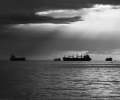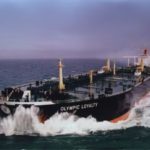Russian oil moving to Asia on older vessels elevates shipping risks: Trafigura CEO

The global oil market has witnessed the mushrooming of smaller trading firms who are moving Russian oil much longer distances to regions like Asia in older ships, potentially raising the risk of shipping errors and accidents, Trafigura CEO Jeremy Weir told the Financial Times Live conference Nov. 23.
Following the start of the Russia-Ukraine conflict, these smaller companies have been set up to fill the trade gap due to bigger companies, such as Trafigura, cutting back on Russian oil trade to comply with international sanctions on Moscow, he said.
“A lot of new companies are being established or smaller companies are growing significantly. We are seeing that all the vessels that typically should have been scrapped are being acquired and are used to transport these fuels. Quite frankly, that’s not acceptable in today’s world,” Weir said.
“And the problem is when oil is going much greater distances — historically the Russian barrel went to Europe and now they are going to India and China — it means much more oil on the water. You have got heightened risk of accidents occurring. It’s a concern ultimately,” he added.
According to S&P Global Commodity Insights, Russia’s seaborne crude exports to Asia increased by around 31% year on year to an average 1.6 million b/d in the first 10 months of 2022. While China’s seaborne crude inflows from Russia surged by 36% year on year to an average of 780,000 b/d in the January-October period, India’s buying from Russia jumped to 450,000 b/d during the same period, compared with 90,000 b/d in the same period a year earlier.
Bigger volumes, thin margins
Trafigura reported a 27% jump in net profit for the six months to March 31 at $2.7 billion, citing sharply higher prices, market volatility and higher trading volumes. Oil and petroleum product volumes in the period rose 14% from the first half of 2021 to an average 7.3 million b/d, while non-ferrous metals volumes grew 16% and bulk minerals volumes 13%.
“It has not been an easy year. What we are seeing is that the market has become more fragmented,” Weir said.
“If you look at pre-COVID period, it was a very efficient global market when customers used to say — this is what I want and what’s the price? During COVID, they used to say — when can I get the cargo due to supply disruptions, this is what I want and what’s the price?
“And now they say — this is what I would like, who is producing it, where is it coming from, what are the multiple supply chains, what’s the carbon footprint of this material, how is [it] going to get here, when it’s going to get here and what’s the price?”
This change of scenario for commodities trading has made the landscape extremely complex and difficult to navigate, as it requires huge amounts of capital to sail through these volatile markets.
“Our turnover is very large but margins are very thin. It’s not that we are seeing an explosion of margins. Margins are slightly higher but not available for everyone to capture. You need high amounts of capital to buffer these highly volatile markets,” Weir said.
He added that the rise in LNG and metals trading volumes had helped the company to more than offset the fall in Russian oil trade volumes, aiding in overall volumes to maintain positive growth.
But Weir added that both the pandemic and the Russia-Ukraine war had prompted companies to rethink their procurement strategy and develop multiple supply chains, instead of being dependent on single sources, in an effort to dilute the risk out of any potential supply disruptions and geopolitical turbulence.
Some changes permanent
Commenting on the need for increased hedging during volatile periods, Weir added that 2022 has been a challenge this year.
“At certain times this year, markets have broken, and have become almost dysfunctional, with very little correlation with underlying physical business. This has been the case for European gas and power markets,” Weir said.
He said that even when the Russia-Ukraine conflict ends, global commodities and energy markets won’t completely revert back to where they were previously, as some changes would be permanent.
“I don’t believe we will revert back to the old system. There are other factors — not just the war — which has led to the current fragmented environment at the moment. People are recognizing that security of resources is extremely relevant. As a result, we can going to see more regionalization,” he added.
Weir added that Trafigura was also preparing to embrace the changing landscape for energy and commodity markets to grab future opportunities.
“We are developing ammonia and hydrogen desks and we are committed to have vessels that can transport these fuels,” Weir said. “People want to know how they can move cargoes efficiently and also with a lower carbon footprint.”
“I think there’s a real recognition that energy transition is metal intensive. It takes up to 10-15 years for a new mine to be developed. Sourcing the material has to be done now,” he added.
Source: Platts

 Hellenic Shipping News Worldwide Hellenic Shipping News Worldwide, Online Daily Newspaper on Hellenic and International Shipping
Hellenic Shipping News Worldwide Hellenic Shipping News Worldwide, Online Daily Newspaper on Hellenic and International Shipping






















 PG-Software
PG-Software